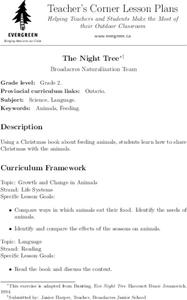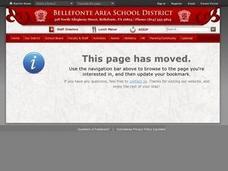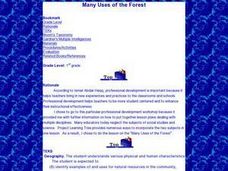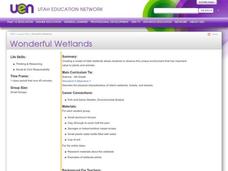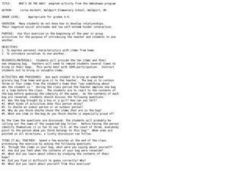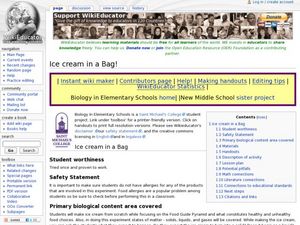Curated OER
KWL Chart: Living and Non Living
In this KWL chart worksheet, students fill in this graphic organizer about living and non-living things. Students complete 3 sections in the chart.
Curated OER
Running Colors
Students play a game with mats of different shapes and colors spread out over a playing area. As a shape and color is called out students run the the corresponding mat and stand on it.
Curated OER
Extinction
Students explore reasons why the dinosaurs became extinct, and the specific needs (habitat, environment, food) of individual types of dinosaurs.
Curated OER
Desinging and Using a Dichotomous Key
Students are examine the purpose of dichotomous keys. In groups, they design their own in order to describe the characteristics of plants and weeds native to California. To end the instructional activity, they define new terminology...
Curated OER
Total English Intermediate: Puzzleword
For this key vocabulary crossword puzzle worksheet, learners practice key vocabulary as they read the 11 clues to correctly fill in the word puzzle. Students also unscramble 6 anagrams and write 6 sentences using the unscrambled words.
Curated OER
Career Explorations and Personal Finance
Students use various search engines and Web sites to find out information for a career they think they might like to pursue. They present their information to the class in an oral report.
Curated OER
The Night Tree
Second graders explore the book, Night Tree, by Eve Bunting. They read and discuss the story, identify what the tree did for the animals, create a food chain for animals to hang on a tree, and decorate a tree at school.
Curated OER
Madeline and the Magnificent Puppet Show
Second graders demonstrate that they are cooperative learners, can solve problems, make decisions and, apply technology to the task through use of the Madeline and the Magnificent Puppet Show
Curated OER
"Oh Deer!"
Students play a game where half of them are deer and the others are components of habitat: food, water, shelter and space. They signify their needs by hand gestures and take what they need to their side of the game. They discuss real...
Curated OER
Many Uses of the Forest
First graders examine pictures of forest wildlife and identify different animals that live in the forest. They discuss resources the forest provides for human use and explore the concept that the forest is used by many at the same time.
Curated OER
Wonderful Wetlands
Fourth graders create a model of Utah wetlands using clay, sponges and soil. They identify the value the wetlands have to plants and animals. They simulate rainfall to observe how wetlands help filter silt and pollutants from the water.
Curated OER
Canine Companions: All Kinds of Dogs
In this family dog lesson, students discover how to choose the type of dog that best fits their family. Students research different types of dog breeds, and share with the class the type of dog they would choose for their family. A...
Curated OER
What Can I Do?
Learners describe the things that citizens can do to reduce ground level ozone and particulate matter. They design a flyer, poster or webpage to teach others about diesel bus retrofitting projects.
Curated OER
Biological Control of Purple Loosestrife
Students examine the role of Purple Loosestrife in Illinois and Indiana rivers. In groups, they collect a wide variety of plants in a wetland and raise beetles in a controlled environment. They introduce the loosestrife into the...
Curated OER
Pulling Together With Natives -- The Bradley Sisters' Story
Students identify the four ways to stop the spread of weeds in California. In groups, they practice the five methods of removing and controling the spread of the weeds. To end the instructional activity, they summarize the Bradley...
Curated OER
Florida Springs
Young scholars discover the many uses of water and the sources of the water we see. They complete a worksheet about the water usage at school and at home.
Curated OER
Sea Turtles
Students investigate eight different species of sea turtles while being involved in classroom lecture and video presentation. The characteristics used to identify sea turtles is taught to help students identify unknown species.
Curated OER
Dishing the Dirt Part 1
Students create a soil center on their school grounds. They begin to write in their science journals. They participate in an experiment that helps the community begin their own gardens.
Curated OER
Who's in the Bag?
Students express personal characteristics with items from home. They introduce themselves to one another.
Curated OER
May I?
Fourth graders learn what a maypole is and how one is made. They write a paper about how one is made and how it be used on the playground.
Curated OER
Extreme Heat
Students, in groups, investigage and demonstrate the science behind the development and characteristics of extreme heat.
Curated OER
Investigation 4 - Dinosaurs Tracks
Fourth graders make inferences and interpretations from sets of dinosaur tracks. They describe Utah fossils and how they were formed. Partners trade their sketches of tracks and try to guess which dinosaur it belonged to.
Curated OER
Winer Survival
Young scholars study how animals need water, food, shelter, and space to survive. They also study what animals need to survive in the winter. They play the part of animals and winter "threats" in a game of tag to reinforce concepts.






